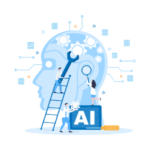 AI into Your Business Strategy can transform operations, offering insights that drive efficiency. Learn how AI shapes decision-making for better outcomes.
AI into Your Business Strategy can transform operations, offering insights that drive efficiency. Learn how AI shapes decision-making for better outcomes.
Artificial Intelligence (AI) is rapidly transforming the business landscape, providing companies with the ability to automate routine operations, optimize resource allocation, and drive growth. Implementing AI into your business strategy can provide a competitive advantage, as it enables informed decision-making and facilitates efficient business processes.
Business AI implementation involves identifying areas within a company where AI integration can provide value and developing a comprehensive strategy for implementation. This includes finding the right AI developer and addressing common integration challenges to ensure a smooth transition.
AI in the Business Context
Artificial intelligence (AI) is revolutionizing the way businesses operate, providing a wealth of opportunities for organizations to make informed decisions and drive efficiency. AI is no longer a futuristic concept, but a tangible reality that is transforming the business landscape across various industries.
One of the primary applications of AI in business operations is in driving data-driven decisions. With AI-enabled tools, businesses can make informed decisions based on vast amounts of data, often in real-time. AI algorithms can provide insights into customer behavior, market trends, and operational inefficiencies that traditional methods may not have uncovered. This ultimately translates into better business strategies and increased profits.
AI is also being used to automate a wide range of business processes, from inventory management to HR tasks. These task automations can help businesses streamline their operations, reduce the risk of human error, and maximize employee productivity. AI-powered chatbots are becoming increasingly popular in customer service, providing fast and efficient ways to interact with customers.
Moreover, AI technologies such as machine learning algorithms are becoming more sophisticated, enabling businesses to create intelligent systems that can learn as they go. This, in turn, allows businesses to develop predictive models that can anticipate future outcomes, such as predicting customer preferences or detecting potential equipment failures.
AI technologies are providing businesses with a new layer of intelligence, enabling them to optimize their operations, make better decisions, and remain competitive in the market. As AI continues to evolve, its potential applications in the business world are limitless.
Identifying Opportunities for AI Integration
Integrating AI into a business’s operations can bring significant value, but it is important to identify the areas where AI can be most effective. Deploying AI technology should not be a standalone objective, but rather a means of achieving business goals and streamlining operations.
The first step is to analyze the existing business processes and identify potential areas where AI can improve efficiency, productivity and accuracy. For example, using AI for labor-intensive and repetitive tasks such as data entry, customer support, and supply chain management can significantly reduce the workload on employees and improve accuracy.
In addition to automating repetitive tasks, AI can be leveraged to enhance decision-making processes in critical business areas such as finance, marketing and sales. AI-powered algorithms can quickly analyze complex data sets and provide insights that can inform strategic decision-making. For instance, AI can be used to analyze consumer behavior patterns, assist in lead generation, and provide personalized marketing campaigns.
It is important to ensure that AI integration aligns with business objectives and avoids dislodging essential processes that are already in place. As such, businesses must evaluate their current infrastructure and determine the areas where AI implementation will add the most value, while minimizing disruptions to current operations.
Developing an AI Strategy
Developing a comprehensive AI strategy is crucial for businesses looking to integrate AI successfully into their operations. The process involves setting clear objectives, identifying required resources, and establishing a roadmap for AI implementation.
Before embarking on an AI strategy, businesses must first decide on the key areas where they want to apply AI. This can be done by analyzing existing business processes and identifying areas where AI can bring significant value. Once these areas have been identified, it is essential to align AI implementation with business goals and processes to maximize its impact.
Setting Clear Objectives
Setting clear objectives is a critical component of developing an effective AI strategy. This involves defining specific goals, such as improving operational efficiency, increasing profitability, or enhancing customer experiences. Businesses must also establish key performance indicators (KPIs) to measure the success of their AI initiatives.
By setting clear objectives and KPIs, businesses can evaluate the performance of their AI solutions and make necessary adjustments to improve performance and achieve ROI.
Identifying Required Resources
Identifying the required resources is essential for successful AI implementation. This includes not only the technology but also the necessary human resources. Businesses must evaluate their existing IT infrastructure, identify skill gaps, and plan for the necessary training to ensure the successful integration of AI.
Moreover, AI requires a significant amount of data to function effectively. As such, businesses must also ensure that their data is of high quality, accurate, and relevant to the AI applications they plan to implement.
Establishing a Roadmap for AI Implementation
Developing a roadmap for AI implementation is critical to ensure a smooth and efficient integration process. This involves identifying the key stages of the implementation process, including planning, testing, deployment, and ongoing monitoring and management.
It is essential to involve all relevant stakeholders in the AI implementation process to ensure their buy-in and support. This includes IT staff, operations personnel, and business leaders who will be responsible for overseeing AI initiatives.
Developing an AI strategy requires a comprehensive approach that involves setting clear objectives, identifying resources, and establishing a roadmap for AI implementation.
Finding the Right AI Developer
When it comes to incorporating AI into your business strategy, finding the right AI developer is crucial. Whether you’re looking to integrate AI into your existing operations or create a custom AI-enabled system, working with an experienced team can help ensure successful implementation and maximize the benefits of AI for your business.
While many businesses opt to hire in-house AI developers, outsourcing to a qualified AI development company can provide various advantages. For instance, hiring AI developers from South America can be a cost-effective solution, as rates are generally lower compared to other regions.
Aside from cost, outsourcing AI development also provides access to a highly skilled and experienced team that specializes in creating AI-enabled systems. These teams typically have experience in developing AI solutions for various industries, making them well-equipped to understand your business needs and find the right AI solutions to meet your goals.
Hire AI Developer
If you’re looking to hire an AI developer, it’s essential to look for certain qualifications and traits to ensure that you find a team that fits your needs. Here are some things to consider:
- Experience: Look for AI developers with a solid track record of developing AI-enabled solutions for companies in your industry or with similar needs. Check references and online reviews to ensure their legitimacy.
- Expertise: Your AI developers should be knowledgeable about the latest advancements in AI and have experience working with a wide range of AI technologies and applications.
- Collaboration: Look for a team that is willing to work closely with you and your team to understand your business needs and integrate seamlessly with your existing systems and processes.
- Communication: It’s essential to find an AI development team that communicates clearly and frequently, keeping you updated on the progress of your project and addressing any concerns or questions along the way.
- Ethics: Ensure that your AI development team operates ethically and is committed to developing responsible AI solutions. Look for a team that prioritizes data privacy, bias mitigation, and transparency in their AI algorithms.
By hiring the right AI developer, you can ensure that your business can enjoy the benefits of AI-enabled systems while avoiding the pitfalls associated with poor AI implementation.
Whether you’re looking to streamline your operations, enhance customer experiences, or gain a competitive edge, the right AI developer can help turn your vision into a reality.
AI Integration Challenges and Solutions
Incorporating AI into business operations can be challenging, with various obstacles that companies may face. However, with careful planning and execution, these challenges can be overcome, and AI can be integrated successfully into business strategies.
Challenge 1: Resistance to Change
One of the most significant challenges companies may face when integrating AI into their operations is resistance to change. Employees may be hesitant to adopt new technologies, fearing job loss or uncertainty about how AI will affect their work.
To overcome this challenge, it is crucial to involve employees in the AI implementation process from the beginning. This can include offering training and education on the benefits and applications of AI technologies. Additionally, highlighting the company’s commitment to employee development and growth can help alleviate fears of job loss.
Solution 1: Having an AI Strategy
Developing an AI strategy is essential to successful AI integration. This includes setting clear objectives, identifying required resources, and establishing a roadmap for implementation.
A well-defined strategy can help identify potential challenges and ensure that AI initiatives are aligned with business goals and processes.
Challenge 2: Limited Resources
Another challenge businesses may face is limited resources, including budget, talent, and time. Integrating AI into operations requires significant investment, both in terms of technology and personnel.
To overcome this challenge, companies can prioritize their AI initiatives and focus on high-impact, low-complexity projects first. Outsourcing to experienced AI developers can also be an effective way to access the required skills and knowledge without committing to full-time personnel.
Solution 2: Collaborative Approach
A collaborative approach to AI integration can also be effective in overcoming challenges. This includes involving employees, stakeholders, and partners in the AI implementation process and encouraging open communication and feedback.
Collaboration can help identify potential roadblocks and ensure that all parties are committed to the success of AI initiatives.
Challenge 3: Data Management
Managing data is a critical aspect of AI integration, as AI algorithms rely on high-quality data to provide accurate insights and predictions. However, many businesses struggle with data management, including data cleaning, storage, and security.
To overcome this challenge, companies can invest in data management tools and platforms that can streamline the data process. It is also essential to establish clear data governance policies and ensure that data is secured and protected.
Solution 3: Continuous Improvement
To ensure the ongoing success of AI integration, companies must adopt a mindset of continuous improvement. This includes regularly evaluating AI performance, identifying areas for improvement, and implementing necessary changes.
Additionally, staying up-to-date with emerging AI technologies and trends can help organizations remain competitive and drive innovation.
Enhancing Efficiency with AI
AI has the potential to significantly enhance business efficiency and productivity by automating repetitive and time-consuming tasks, as well as optimizing resource allocation. By implementing AI in operations, businesses can streamline processes, reduce costs, and increase output.
One of the most prominent AI applications for enhancing efficiency is robotic process automation (RPA). RPA uses AI-powered software robots to automate tasks such as data entry, report generation, and invoice processing. This frees up employees to focus on more complex tasks, leading to higher productivity and faster turnaround times.
Another way businesses can use AI to enhance efficiency is through predictive analytics. By analyzing historical data, AI algorithms can predict future trends and outcomes, allowing businesses to make informed decisions about resource allocation and process optimization. This can lead to better inventory management, reduced waste, and improved customer satisfaction.
AI can also enable businesses to optimize their supply chain operations. By analyzing data from various sources, such as production schedules, transportation routes, and demand forecasts, AI algorithms can create optimized supply chain plans that minimize waste and reduce costs. This can lead to faster delivery times, improved sustainability, and increased profitability.
Incorporating AI into business operations can lead to significant improvements in efficiency and productivity, ultimately driving business growth.
AI for Competitive Advantage
The use of AI provides businesses with a powerful tool to gain a competitive advantage in the market. By analyzing vast amounts of data and providing valuable insights, AI can help businesses develop effective strategies that drive growth and enhance customer experiences.
One of the key benefits of AI is its ability to analyze market trends and consumer behavior. With this information, businesses can create personalized marketing strategies and improve customer engagement, resulting in increased sales and brand loyalty. For instance, AI-powered chatbots can interact with customers, answer their queries, and provide personalized recommendations based on their past interactions with the business.
AI can also optimize business operations, automating repetitive tasks and streamlining workflows. This increases efficiency, reduces costs, and allows businesses to focus on their core competencies. For example, AI algorithms can help businesses allocate resources more effectively, predict demand patterns, and prevent supply chain disruptions.
Another key advantage of AI is its ability to process vast amounts of data. By analyzing large datasets, AI algorithms can detect patterns and anomalies that may be missed by human analysts. This can help businesses identify trends, detect potential risks, and make informed decisions that improve their bottom line.
To maximize the competitive advantage of AI, businesses must develop a comprehensive AI strategy that aligns with their goals and processes. This involves identifying areas where AI can provide the most value and selecting the right AI technologies and solutions to support these areas.
By leveraging AI for competitive advantage, businesses can gain a deeper understanding of their customers, optimize their operations, and make more informed strategic decisions. With the right AI solutions and strategies in place, businesses can position themselves for long-term growth and success in an increasingly competitive market.
AI-Enabled Customer Experience
One of the most significant benefits of incorporating AI into business operations is its potential to enhance the customer experience. With the help of AI algorithms, businesses can provide personalized and efficient services to their customers, resulting in stronger brand loyalty and increased sales.
AI-powered chatbots are a prime example of how AI can improve customer interactions. These chatbots utilize natural language processing (NLP) and machine learning algorithms to simulate human-like conversations with customers. They can provide personalized recommendations, answer frequently asked questions, and resolve basic customer queries, freeing up customer support teams to deal with more complex issues.
Another way AI can improve the customer experience is through predictive analytics. By analyzing customer data, businesses can gain insights into their behavior and preferences, allowing them to tailor their marketing strategies accordingly. For instance, AI can help companies create targeted marketing campaigns, recommending products or services based on a customer’s past behavior and interactions with the business.
AI-Driven Business Decisions
AI can also assist in making informed business decisions, resulting in better outcomes and improved profitability. By analyzing vast amounts of data, AI algorithms can identify patterns and trends that might not have been immediately noticeable to human analysts.
For example, AI algorithms can assist in fraud detection by analyzing customer data and identifying patterns of suspicious behavior. This not only protects the business and its customers from financial losses but also helps maintain the trust of customers in the brand.
In conclusion, AI has the potential to revolutionize the way businesses interact with their customers and make informed decisions. By implementing AI technologies and applications, businesses can stay competitive and drive growth, improving the overall customer experience and streamlining operations.
AI for Data Analysis and Insights
One of the most fundamental ways in which AI can revolutionize businesses is by using it to analyze data and provide insights that drive strategic decision-making. Leveraging AI algorithms for data processing, anomaly detection, and pattern recognition can unlock unprecedented insights into customer behavior, market trends, and internal operations.
Integrating AI into business operations for data analysis and insights requires a comprehensive AI strategy in companies. Key considerations in developing such a strategy include identifying the necessary resources, data governance policies, and establishing clear objectives.
By leveraging AI for data analysis and insights, businesses can optimize their decision-making processes and drive growth; however, implementing this technology is not without its challenges. Organizations may face issues such as data privacy concerns and the potential for bias in AI algorithms. It is essential to approach AI adoption with a responsible and ethical lens, ensuring that data privacy policies are compliant with relevant regulations and that AI algorithms are transparent and free from bias.
Ultimately, successfully incorporating AI into data analysis and insights can enable businesses to gain a competitive edge and drive innovation in their respective industries. By embracing this technology, companies can unlock a wealth of valuable insights that were previously unattainable, making AI a critical component of a comprehensive AI business solution.
Ensuring Ethical and Responsible AI Use
As AI continues to advance and become more integrated into business operations, it is crucial for companies to consider the ethical implications of its use. It is important to ensure that AI technology operates within legal and ethical boundaries, and that its usage aligns with company values and objectives.
One key consideration is data privacy. Companies must ensure that the data they collect and use in AI systems adhere to privacy laws and regulations. They must also ensure that they are transparent with their customers about what data is being collected and how it will be used.
Another consideration is bias mitigation. AI algorithms can unintentionally perpetuate biases based on the data they are fed. Companies must take steps to identify and address these biases to ensure that their AI systems are fair and unbiased. This includes diversifying data sets, testing for bias, and implementing bias-mitigating algorithms.
Transparency in AI algorithms is also essential. Companies should be able to explain how their AI systems make decisions and provide clear reasons for those decisions. This can help build trust with customers and stakeholders.
Companies must approach AI implementation with an ethical and responsible mindset. Incorporating ethics into AI strategy can help prevent negative consequences and ensure that AI is used to benefit society as a whole.
Measuring AI Performance and Return on Investment
One of the critical aspects of incorporating AI into business strategies is measuring its performance and return on investment. This helps businesses evaluate the effectiveness of their implementation and identify areas for improvement. Here are some key considerations for measuring the performance and return on investment of AI initiatives:
Defining key metrics:
Businesses must establish clear metrics to measure the performance of AI initiatives. These metrics should align with the business objectives and KPIs and should be measurable over time. For example, if the objective is to reduce customer wait times, the metric could be the average time taken to resolve a customer query.
Evaluation methods:
There are various methods businesses can use to evaluate the performance of AI initiatives. One approach is to conduct A/B testing, where two or more approaches are compared to identify the most effective one. Another method is to use control groups, where the performance of AI-backed operations is compared to those without AI.
Continuous improvement:
The AI landscape is dynamic, and businesses must continuously improve their AI systems to keep up with the changes. One way of achieving this is by monitoring the performance metrics regularly and updating the system as necessary. Additionally, businesses can seek feedback from stakeholders and use it to enhance the AI solution continually.
Return on investment:
AI implementation requires significant investment in terms of time and resources. Therefore, businesses must evaluate the return on investment (ROI) to justify their investment in AI. ROI is calculated by comparing the cost of implementing AI solutions to the benefits it generates. These benefits could include reduced operational costs, increased revenue, or improved customer experience.
Integrating AI into business operations:
To accurately measure the performance and ROI of AI initiatives, businesses must integrate AI into their operations fully. This requires close collaboration between business and technical teams to ensure all relevant data is captured and analyzed. Additionally, businesses must have a clear understanding of their AI solution’s impact on their operations and be willing to make changes where necessary to optimize its performance.
By prioritizing performance metrics, using effective evaluation methods, continuously improving their AI systems, and evaluating ROI, businesses can maximize the benefits of incorporating AI into their operations. This, in turn, can lead to improved efficiency, increased productivity, and increased revenue, making AI a valuable business solution to consider.
AI Adoption in Different Industries
AI technologies are being increasingly integrated into diverse industries, driving growth and innovation. By leveraging AI, businesses have the potential to optimize their operations, increase efficiency, and create new revenue streams. Here are some examples of how AI is being adopted in different industries:
| Industry | AI Business Solutions |
|---|---|
| Healthcare | AI is being used to analyze medical records and diagnostic images, detect diseases at an early stage, and predict patient outcomes. It is also being used to develop personalized treatment plans and assist in drug development. |
| Retail | AI is being used to analyze customer behavior and preferences, enabling personalized recommendations and targeted marketing campaigns. It is also being used to optimize supply chain management, reduce inventory costs, and forecast demand. |
| Finance | AI is being used to analyze market trends, predict stock prices, and automate trading. It is also being used to prevent fraud, provide personalized financial advice, and assist in credit scoring. |
| Manufacturing | AI is being used to optimize production processes, reduce downtime, and control quality. It is also being used to predict equipment failures and schedule maintenance, while also assisting in supply chain management. |
As AI technologies continue to evolve, the potential for their adoption in different industries will only continue to grow. Businesses that embrace AI solutions have the potential to gain a competitive advantage and drive business growth.
Overcoming Resistance to AI Implementation
Integrating AI into business operations can be a daunting task for many organizations, as it requires significant investment and a shift in the way work is done. As a result, some employees may resist AI implementation, fearing job loss or unfamiliar technology. However, overcoming this resistance is crucial for the successful adoption of AI in companies.
One effective strategy for overcoming resistance to AI implementation is to involve employees in the process. By providing training and upskilling opportunities, employees can learn how to work with AI and understand its benefits. Additionally, involving employees in the decision-making process and incorporating their feedback can improve buy-in and increase employee engagement.
Another approach is to create a culture that embraces AI technologies. Leaders should communicate the importance of AI implementation in achieving business goals and emphasize the benefits of AI for employees, customers, and the organization as a whole. This can create a sense of excitement and encourage employees to embrace change rather than resist it.
Ensuring that AI implementation aligns with the overall business strategy can enhance its effectiveness and reduce resistance. By integrating AI into existing workflows and processes, employees can see firsthand how it can improve efficiency and drive growth. This can also help to alleviate any concerns about job loss, as employees can see how AI can assist them rather than replace them.
Overcoming resistance to AI implementation is crucial for businesses looking to stay competitive in the market. By involving employees, creating a culture that embraces AI, and aligning AI implementation with business goals, companies can successfully integrate AI into their operations and reap its benefits.
External Resources
https://en.wikipedia.org/wiki/Artificial_intelligence
https://www.ibm.com/topics/artificial-intelligence
FAQ
FAQ 1: How can I integrate AI to improve customer service in my business?
Answer: Integrating AI into your customer service can significantly enhance response times and personalize user experiences. Chatbots powered by AI can handle inquiries 24/7, providing immediate answers to common questions. Here’s a simple example of setting up a chatbot using Python with the ChatterBot library:
from chatterbot import ChatBot
from chatterbot.trainers import ChatterBotCorpusTrainer
chatbot = ChatBot('BusinessBot')
trainer = ChatterBotCorpusTrainer(chatbot)
# Train the chatbot with English language corpus
trainer.train("chatterbot.corpus.english")
# Get a response for an input statement
response = chatbot.get_response("What are your business hours?")
print(response)This code snippet demonstrates creating a basic chatbot that learns from pre-existing conversational datasets. Implementing such a chatbot on your customer service portal can offload routine queries from human staff, allowing them to focus on more complex issues.
FAQ 2: Can AI help in analyzing customer feedback and market trends?
Answer: Yes, AI can play a crucial role in analyzing vast amounts of customer feedback and identifying market trends. Sentiment analysis, done through natural language processing (NLP), allows businesses to gauge customer sentiment from reviews, social media, and other text sources. Here’s an example using Python’s TextBlob library for simple sentiment analysis:
from textblob import TextBlob
feedback = "I love the new update, much more user-friendly!"
blob = TextBlob(feedback)
print(blob.sentiment)
This code analyzes the sentiment of a piece of customer feedback, returning polarity and subjectivity scores. Polarity measures positivity or negativity, while subjectivity measures factual vs. opinionated content. By automating this process, businesses can quickly understand customer sentiment at scale, informing product development and marketing strategies.
FAQ 3: How can I use AI to optimize my inventory management?
Answer: AI can optimize inventory management by forecasting demand and automating restocking decisions. Machine learning models can predict future sales based on historical data, trends, and other variables such as seasonality. Here’s a conceptual example using scikit-learn, a Python library for machine learning:
from sklearn.ensemble import RandomForestRegressor
import numpy as np
# Hypothetical sales data: [[month, product_id, price], sales]
X = np.array([[1, 101, 20], [2, 101, 20], [3, 102, 15]])
y = np.array([200, 180, 300]) # Corresponding sales
# Train a random forest regressor model
model = RandomForestRegressor()
model.fit(X, y)
# Predict future sales for a given month, product, and price
future_sales = model.predict([[4, 101, 20]])
print(f"Predicted sales: {future_sales[0]}")Although simplified, this example illustrates how machine learning can predict sales, aiding in making informed inventory decisions. By leveraging AI for inventory forecasts, businesses can reduce overstock and stockouts, improving operational efficiency and customer satisfaction.
Integrating AI into your business strategy, from customer service enhancements to inventory optimization, can lead to significant improvements in efficiency, customer satisfaction, and strategic insight. These examples provide a glimpse into the practical applications of AI within various business functions.
Jane Watson is a seasoned expert in AI development and a prominent author for the “Hire AI Developer” blog. With over a decade of experience in the field, Jane has established herself as a leading authority in AI app and website development, as well as AI backend integrations. Her expertise extends to managing dedicated development teams, including AI developers, Machine Learning (ML) specialists, and other supporting roles such as QA and product managers. Jane’s primary focus is on providing professional and experienced English-speaking AI developers to companies in the USA, Canada, and the UK.
Jane’s journey with AI began during her time at Duke University, where she pursued her studies in computer science. Her passion for AI grew exponentially as she delved into the intricacies of the subject. Over the years, she honed her skills and gained invaluable experience working with renowned companies such as Activision and the NSA. These experiences allowed her to master the art of integrating existing systems with AI APIs, solidifying her reputation as a versatile and resourceful AI professional.
Currently residing in the vibrant city of Los Angeles, Jane finds solace in her role as an author and developer. Outside of her professional pursuits, she cherishes the time spent with her two daughters, exploring the beautiful hills surrounding the city. Jane’s dedication to the advancement of AI technology, combined with her wealth of knowledge and experience, makes her an invaluable asset to the “Hire AI Developer” team and a trusted resource for readers seeking insights into the world of AI.






